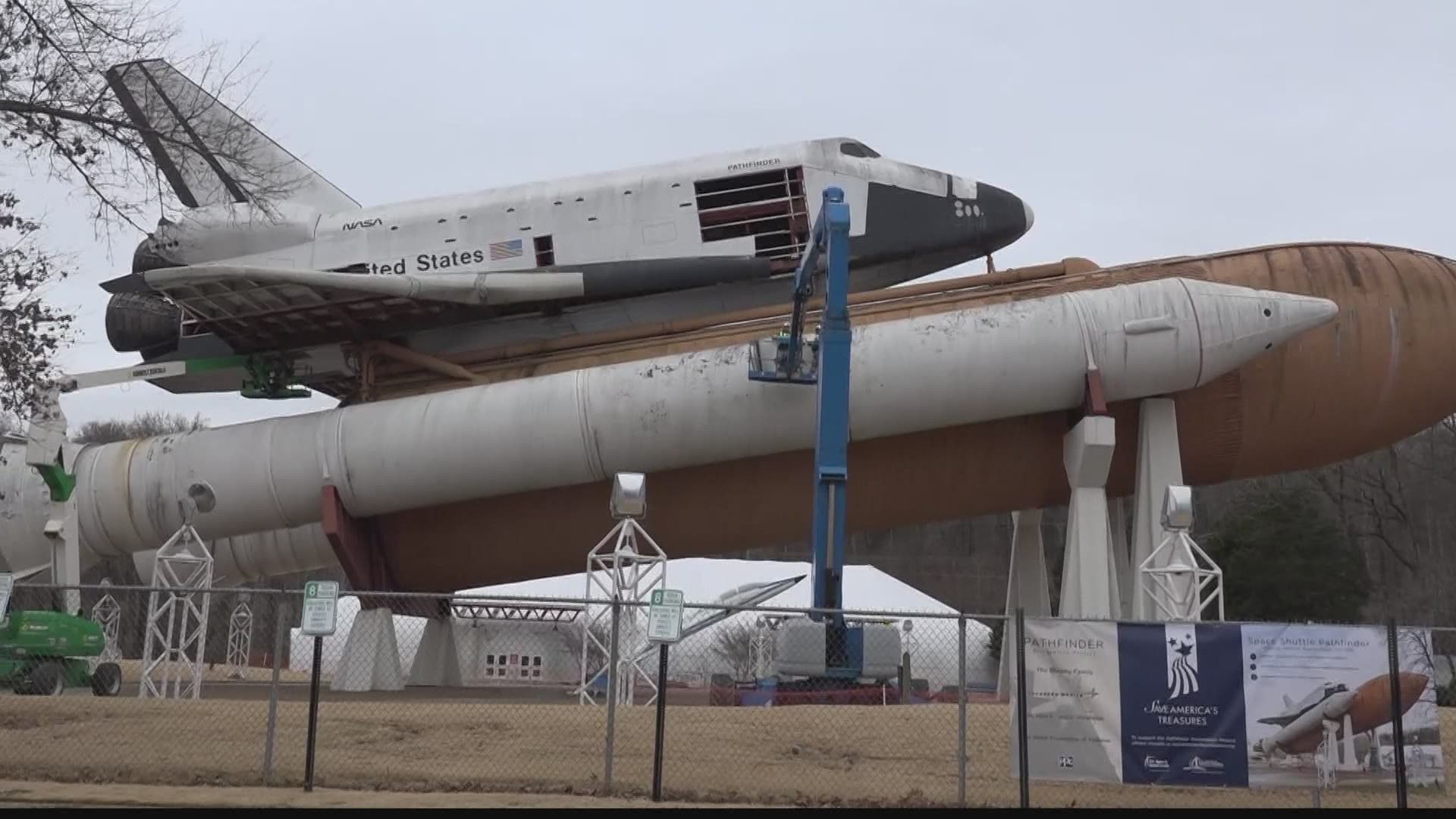HUNTSVILLE, Ala — The multi-year restoration project of the Pathfinder Space Shuttle display, located in the Rocket Center's shuttle park, is now in phase one.
This phase of restoration will include removing the Pathfinder orbiter from the top of the external fuel tank.
Restoring the Pathfinder was supposed to be a top priority for the year 2020, but due to financial reasons and reduced attendance to the museum, both caused by the COVID-19 pandemic, they had to put the project on hold.
In August, the Rocket Center received a $500,000 "Save America’s Treasures" grant from the National Park Service alongside many other donations to make the project possible.
The Pathfinder shuttle stack was at the Rocket Center in 1988 and has remained the only full-stack shuttle exhibit in the world since that then. The Pathfinder was originally used to test handling, transportation and other procedures for the Space Transportation System. Pathfinder is a name NASA gives to equipment used to test infrastructure and logistics.
"In the early 1980s, a group of Japanese businessmen paid to modify the structure with plywood and fiberglass to more closely resemble a real orbiter and displayed it from 1983 to 1984 at an exposition in Tokyo, Japan. After the expo, Pathfinder returned to Huntsville and was mounted for the display seen today. More than 30 years of exposure to the elements have caused the modified elements to deteriorate, resulting in the need to bring the orbiter down," according to the U.S. Space and Rocket Center.
"I think about the Huntsville community and how many people in this town worked on this program, or had a relative, or a neighbor who worked on this program, it's part of Huntsville's DNA, and as Huntsville is growing and changing and becoming, you know, an international city, it's important to remember that this town has always had such a technological drive," said Dr. Kay Taylor, the VP of education at USSRC.
Here is some of the basic information about the Pathfinder:
The Pathfinder shuttle stack is an outdoor static display of the early Space Transportation System (STS), also known as the Space Shuttle Program.
The Pathfinder display consists of the following primary historic elements:
· Pathfinder Orbiter – Though highly modified, the Pathfinder orbiter is a winged test article used to verify fitment of handling and transport equipment, train staff on handling procedures and post-flight defueling procedures for the orbiters maneuvering engines.
· External Tank (ET) Serial No. 1, also known as Main Propulsion Test Article External Tank (MPTA-ET) – This tank was used to verify the design of the External Tank that provided liquid oxygen and hydrogen to the Space Shuttle Main Engines and to help verify the Space Shuttle Main Engine during preflight qualification testing.
· Fiber-wound Composite Solid Rocket Boosters (SRBs) – A pair of prototypes, super-lightweight SRBs developed for STS launches from Vandeberg Air Force Base in California. This SRB program was discontinued after the loss of the Challenger vehicle in 1986.
· Space Shuttle Main Engines (SSMEs) – The three engines mounted on the back end of the orbiter are a trio of program used engine nozzles and combustion chambers. The top engine was flown on STS-1, the first shuttle flight, while the bottom two were engineering development engines.
The stack is supported by a set of six pyramidal columns. The orbiter is directly mounted to the appropriate mounting points in the ET. The SRBs are supported at the foreend by a steel cradle on their own columns. The aft end of the boosters are supported in a cradle that spans the width of the entire display and cradles the other SRB and the ET. The ET is supported by points mounted on pyramidal columns at the forward end. At the aft end, they are supported by the same cradle that supports the SRBs.
Specifications for the stack:
· Display Attitude: 10 degrees
· Max Height (at top of vertical stabilizer, calculated): 79.92 feet
· Max Width (Orbiter wingspan): 78.06 feet
· Lowest Point Height (SRB aft skirt to ground): 10 feet
Orbiter only specifications:
· Max Height: 56.67 feet
· Max Width: 78.06 feet
· Length: 122.2 feet
· Estimated Weight: 143,421 pounds
Information provided by the USSRC.

